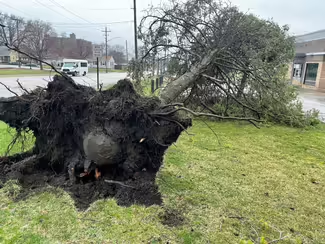
Balled and burlap trees: Remove the burlap
April is arbor month and April 28, 2023, is Arbor Day. This is a day inspired by the multitude of benefits trees provide, the desire to have more trees in our communities, and a call to action to plant trees on this day. I have spent my entire career planting trees and my entire life admiring, climbing, and loving trees so for me, planting young trees and caring for established trees is a passion (perhaps nearing the point of obsession). So, when our community was impacted by a strong storm with a confirmed EF1 tornado a few weeks ago, I went out to inspect the trees as soon as the weather cleared.
I found what I was expecting to find, limbs broken or damaged, trees uprooted, property damaged, and the heartbreaking loss of some magnificent trees. I have seen this type of damage before, but it is always hard to witness. As I explored one of the hardest-hit areas, I found something surprising. I found an uprooted tree that had the bur-lapped root ball perfectly intact.
Based on what I saw, I am estimating a contractor planted the spruce tree ten to fifteen years ago. The specifications likely called for a larger tree, meaning a balled-and-bur-lapped tree was planted. Upon planting, the burlap was not removed from the root ball (that is why it looks like a ball is stuck in the middle of this root system).
Passionate discussions have been had and continue regarding the best planting methods for balled and burlap trees. Burlap and a wire cage or twine basket are used to secure the root ball of a field-grown tree as it is moved from the nursery to the final planting areas. This material plays an important role in preserving the roots that remain. The debate begins once the tree has reached its destination.
Although research is limited, evidence suggests the best practice for planting balled and burlap trees is to remove as much of the burlap and cage as possible, aiming to remove 1/3 to ½ of the burlap and basket, once the tree has been placed into the planting hole. Removing the burlap and cage prior to placement in the ground can compromise the root ball and increase transplant shock, the need for staking, and an extended establishment period.
The other side of the conversation reasons that the burlap is a natural material that will decompose naturally and leaving the root ball intact at the time of planting will preserve the soil structure and rootzone during early establishment. Based on the tree I found, burlap decay is not a guarantee. Anaerobic and seasonal conditions, synthetic materials, and chemical treatments to burlap prevent materials from decomposing. If the burlap does not deteriorate, the tree’s roots are unable to grow into the surrounding soil where they anchor the tree and access essential moisture and nutrients. The long-term health of the plant and the safety of people and structures adjacent to the tree are threatened.
While some choose to continue the debate, I am more concerned with what we do in the here and now. Expert recommendations are to remove the burlap and cage at planting time. Trees are an investment of time, energy, financial resource, and materials, why leave the long-term health and well-being of the tree to chance by hoping the burlap will deteriorate in time for the roots to develop into the surrounding soil? Trees can be determined to survive as evidenced by the fallen spruce I found. The tree continued to grow even though the root system was underdeveloped, and the tree was stressed. Many years after it was planted but decades before it should have, the tree failed. What remains is a tree that needs to be cleaned up, a landscape that is missing a mature tree, and resources wasted. The only silver lining I can find is that this particular tree didn’t fall onto a structure or harm a person. But there is no guarantee other trees planted in this manner won’t cause human harm or property damage. It is not worth the risk.
Balled and burlap trees are very large, heavy trees primarily planted by people in the landscape industry. Rarely are homeowners planting balled and burlap trees but that doesn’t mean community members are helpless to advocate for proper planting of trees. If you, any organizations you are affiliated with, or your community hire someone to plant a ball and burlap tree, double-check that they have removed the burlap from the root ball before sending a final payment. You can check by removing some of the soil/ mulch from the newly planted tree. If the burlap remains, it will be obvious. Demand it be corrected or your tree may fail decades before it should.
Trees are valuable assets in our landscape and are meant to be long-term investments. Proper planting and care maximize those investments. In the event a tree is lost, replanting is recommended, and Illinois Extension is able to help you choose the right tree for the right place.
Good Growing Fact of the Week: Morton Arboretum in Lisle, Illinois was founded by Joy Morton, a prominent Chicago industrialist, founder of Morton Salt Company, and son of Arbor Day founder J. Sterling Morton.
PHOTO INFORMATION: Photo by Emily Swihart, University of Illinois Extension. Caption: A fallen spruce tree reveals a root ball constrained by burlap not removed at the time of planting.
Thank you for reading!
Sign up for our emails! Want to get notified when new Good Growing posts are available? SIGN ME UP
MEET THE AUTHOR
Emily Swihart is a Horticulture Educator with the University of Illinois Extension, serving Henry, Mercer, Rock Island, and Stark counties since 2021. Emily provides horticulture programming with an emphasis on trees, native vegetation, and home landscape design.
